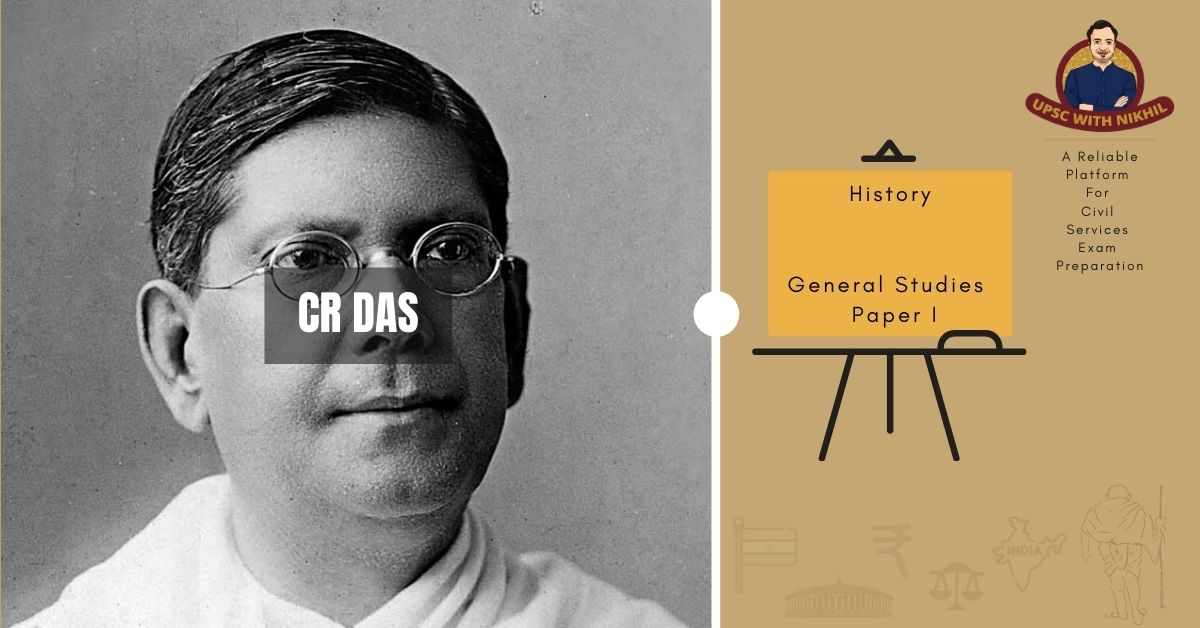Chittranjan Das
Chittaranjan Das popularly called Deshbandhu was an Indian Freedom Fighter, political activist and lawyer during the Indian Independence Movement and founder-leader of the Swaraj Party.
• Chittaranjan Das was born on 5 November 1870 in Calcutta in a well-known Baidya Brahman family of Bikrampur, Dhaka (present day Bangladesh).
• He was the son of Bhuban Mohan Das, and nephew of the Brahmo social reformer Durga Mohan Das who worked in the field of woman’s liberation and widow remarriage.
• His family were actively members of Raja Ram Mohan Roy’s Brahmo Samaj.
• He married four times to Basanti Devi, Aparna Devi, Chiraranjan Das and Kalyani Devi.
• In 1890, Das completed his graduation from Calcutta’s Presidency College and then went to England to Pursue higher studies and take the Indian Civil Services Exam which he could not clear.
• He finished his law studies from England and returned to India in 1893.
• In London he became friends with Sri Aurobindo Ghosh, Atul Prasad Sen and Sarojini Naidu among others and together they promoted Dadabhai Naoroji in the British Parliament.
CAREER
• He practiced law for many years at the Calcutta High Court.
• He appeared in defence of freedom fighters Brahmabandhab Upadhyay and Bhupendranath Datta who were charged with sedition.
• In the 1908 Alipore Bomb Case, he successfully defended Aurobindo Ghosh and gained fame among Indians.
• Das along with Bipin Chandra Pal and Aurobindo Ghosh contributed to the English weekly ‘Bande Mataram’ to spread the ideals of Swaraj.
• He was actively involved with the activities of Anushilan Samiti.
• He entered active politics in 1917 when he played a significant role in the controversy over the election of Mrs. Annie Besant as President of Indian National Congress for its Calcutta Session.


• In the Calcutta session he proposed a plan for village reconstruction to make them self reliant with steps using Co-Operative Credit Societies, Local Self Government as well as re-starting cottage industries.
• He burnt his own European Clothes during Non-Cooperation Movement and started wearing Khadi.
• It has been said that, his clothes used to tailored and washed in Paris and then shipped to him but after joining the Freedom Movement he gave up his luxurious life and started Simple Living.
• A newspaper called FORWARD was started by him and later its name was changed to LIBERTY to fight the British Raj. Netaji Subhas Chandra Bose was the editor of this newspaper. Bose considered CR Das as his mentor.
• He became the first Mayor of Calcutta Municipal Corporation.
• He resigned from presidency of Indian National Congress at GAYA session after losing a motion on “No Council Entry” to Gandhi’s faction.
• He along with Motilal Nehru formed the Swaraj Party to express his opinion and dissatisfaction with the Indian National Congress. The aim of the Swaraj Party was to contest elections in the Central Legislative Assembly in 1923 and derail the British rule through Anti-Government Activities within the council chambers.
• In 1925 when his health started getting worse he went to stay in Darjeeling to improve his health. Das died of a sever fever on 16 june 1925 in Darjeeling and his mortal remains were brought to Calcutta for his funeral. Gandhi led the funeral procession.
• Swaraj Party was disbanded after his death.
• He was also a prolific writer and poet. He published two volumes of collection of poems called MALANCHA and MALA. In 1913 he published Sagar Sangeet (The Songs of the Sea).
• Das started a monthly journal named Narayana and many eminent writers such as Sharat Chandra Chattpadhyay, Bipin Chandra Pal , Hariprasad Shastri contributed their writings in the journal.
LEGACY
• Das gifted some of Kolkata property including his house and the adjoining lands to the nation to be used for the betterment of the lives of women.
• STEP ASIDE, the last abode of Das in Darjeeling is now a Mother and Child Care Centre run by the government.


